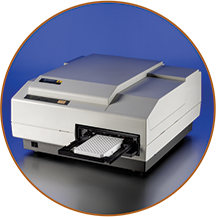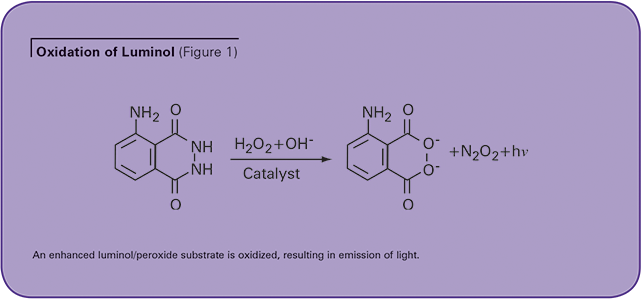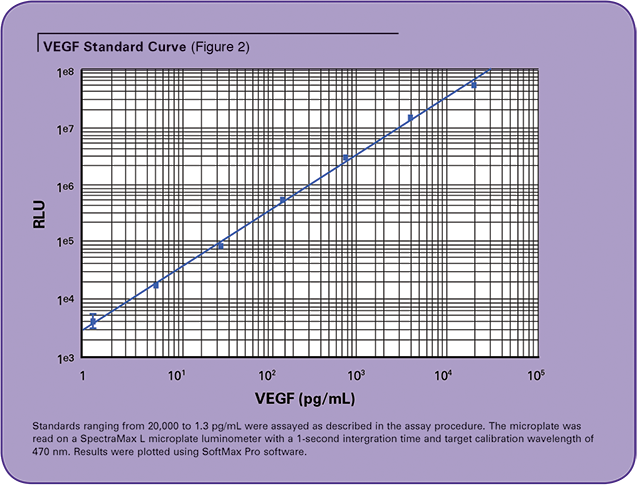
Application Note
Chemiluminescent VEGF ELISA Using the SpectraMax L Microplate Luminometer
By Cathy Olsen, Ph.D., Molecular Devices, Inc., 1311 Orleans Drive, Sunnyvale, CA 94089.

Introduction
Vascular endothelial growth factors (VEGFs) are a family of secreted polypeptides that have been implicated in mammalian vascular development and in disease processes involving abnormal blood vessel growth. VEGFs are expressed during embryogenesis, where deletion of even a single VEGF allele severely disrupts vasculogenesis and is embryonic lethal. VEGF165is the most abundant and biologically active isoform of VEGF found in mammals.1The QuantiGlo Chemiluminescent VEGF Immunoassay is a solid phase ELISAthat measures VEGF165levels in cell culture supernatants, serum, plasma, saliva, and urine. It uses the quantitative sandwich enzyme immunoassay technique in which a monoclonal antibody specific for VEGF is coated onto a microplate and standards and samples are added to the wells.2Unbound material is washed away, and a horseradish peroxidase-linked polyclonal antibody-specific for VEGF is added to the wells. An additional series of washes removes unbound antibody-enzyme reagent, then an enhanced luminol/peroxide substrate is added to the wells. (See Figure 1.) Light produced in proportion to the amount of VEGF initially bound to the wells is then measured using a microplate luminometer. Assay results were detected using the SpectraMax®L microplate luminometer. This instrument is suitable for both flash and glow applications and is compatible with 96- and 384-well microplate formats. Its dedicated luminescence optical design yields an extremely high signalto-noise ratio and extremely low crosstalk, with a dynamic range of more than eight orders of magnitude. Similar results may be obtained using the luminescence mode of SpectraMax®M5/M5eand FlexStation®3 multi-mode microplate readers. Data collection and calculations were performed using SoftMax®Pro software, which includes preconfigured protocols to simplify data acquisition and analysis.

Materials
- QuantiGlo Human VEGF Immunoassay (R&D Systems P/N QVE00B). This kit contains all of the reagents and materials required to perform the assay, including assay standards and a microplate pre-coated with a monoclonal antibody specific for VEGF.
- SpectraMax Lmicroplate luminometer. Note: this assay can also be detected using the luminescence mode of SpectraMax M5/M5 e and FlexStation 3multi-mode microplate readers.
Methods
Preparation of reagents and standards
Step 1. All reagents were brought to room temperature before use.
Step 2. Wash Buffer Concentrate was diluted 10-fold with deionized water.
Step 3. Working Glo Reagent was prepared 15 minutes to 4 hours before use by combining 1 part Glo Reagent A and 2 parts Glo Reagent B in a capped plastic tube, protected from light.
Step 4. The VEGF standard was reconstituted with 0.5 mL deionized water and allowed to sit for a minimum of 15 minutes, with gentle agitation prior to making dilutions. Working standards were prepared by making a serial 1:10 dilution of the stock standard in Calibrator Diluent RD5L. Concentrations of working standards ranged from 20,000 to 1.3 pg/mL.
Assay procedure
Step 1. 150 μL of Assay Diluent RD1-8 was pipetted into each well.
Step 2. 50 μL of working standard or blank (Calibrator Diluent) was pipetted into triplicate wells of the supplied microplate. The microplate was incubated for 2 hours at room temperature with shaking (500 ± 50 rpm recommended).
Step 3. Wells were aspirated and washed 4 times with 400 μL Wash Buffer using a multichannel pipettor. After the last wash, the remaining Wash Buffer was aspirated and the plate was blotted against clean paper towels.
Step 4. 200 μL of VEGF Conjugate was added to each well, and a new adhesive strip was applied. The microplate was incubated for 3 hours at room temperature, with shaking as in step 2.
Step 5. Aspiration and washing steps were repeated as in step 3.
Step 6. 100 μL Working Glo Reagent was added to each well. The microplate was incubated for 5-20 minutes at room temperature, protected from light.
Step 7. RLU values were determined using the SpectraMax L microplate luminometer. Instrument settings included the following: 1 second integration time, AutoRange PMT setting, and 470 nm target calibration wavelength.
Results
Figure 1 shows the VEGF standard curve obtained with the SpectraMax Lmicroplate luminometer using the settings outlined above. The dynamic range for this assay spans greater than four orders of magnitude, with a calculated sensitivity of about 1.5 pg/mL, based on a concentration giving a signal 3 times the standard deviation of the background. This correlated well with R&D Systems’ claim of a mean minimum detectable dose of 3.3 pg/mL for the kit. The SpectraMax M5 and FlexStation 3 multi-mode microplate readers yielded similar results (data not shown). Results were analyzed and the standard curve was plotted using SoftMax Pro software.

Summary
The Quantiglo Human VEGF Immunoassay is a highly sensitive method for assaying VEGF in a variety of sample types. The SpectraMax L microplate luminometer with SoftMax Pro software provides excellent sensitivity and dynamic range for this assay as well as simplified data acquisition and analysis.
References
- Holmes, David IR and Zachary, Ian (2005). The vascular endothelial growth factor (VEGF) family: angiogenic factors in health and disease. Genome Biology 6: 209.
- Quantiglo Human VEGF Immunoassay (P/N QVE00B) package insert.
By Cathy Olsen, Ph.D., Molecular Devices, Inc., 1311 Orleans Drive, Sunnyvale, CA 94089.

简介:
血管内皮生长因子(Vascular Endothelial Growth Factor,VEGFs)是一类分泌类 多肽,其参与哺乳动物的血管发育和病理 下血管的异常增生。在胚胎发生中已有 VEGFs的表达,而敲除VEGFs,哪怕是 一个VEGF等位基因的敲除都会严重影响 血管发育并胚胎致死。在哺乳动物中, VEGF165是丰度最高的具有生物学活性 的VEGF亚型1。QuantiGlo VEGF化学 发光免疫测定法是应用固相ELISA分析细 胞培养上清,血清,血浆,唾液和尿液等 样本中VEGF165的水平。该方法基于定 量免疫反应技术,将VEGF特异的单克隆 抗体包被在96孔板上,并加入标准品和样 品2。在清洗掉未结合的成分后,加入辣 根过氧化酶偶联的VEGF特异多抗至孔 中。进一步通过清洗过程除去未结合抗体 -酶复合物,最后加入luminol/peroxide 底物(见图1)进行化学发光反应,其光强 度和起始结合到孔板上的VEGF量成比 例,并可以用微孔板化学发光酶标仪进行 测量。
本应用中使用SpectraMax® L微孔板化学 发光酶标仪进行检测,其兼容96和384孔 板的快反应和慢反应体系。专为化学发光 检测设计的光路设计使SpectraMax® L具 有出众的信噪比率,更低的孔间干扰和超 过8个数量级的动力学范围。SpectraMax® M5/M5e和FlexStation® 3多功能酶标仪 的化学发光检测模式也能提供可比的结 果。数据的收集和计算由SoftMax® Pro 软件完成,其预设的模板极大的简化相 应流程。

图1:增强luminol/peroxide底物用于化学发光检测
材料
- QuantiGlo人VEGF免疫测定试剂盒 (R&D Systems P/N QVE00B)。该 试剂盒包括标准品,预包被抗VEGF 单抗板等相关试剂。
- SpectraMax L微孔板化学发光酶标仪。 注意:该实验也可以用SpectraMax® M5/M5e和FlexStation® 3多功能酶 标仪的化学发光检测模式进行检测。
方法
试剂和标准品的准备
- 实验前将所有试剂平衡至室温。
- 用去离子水10倍稀释洗涤液储液。
- 使用前15分钟至4小时之内在塑料管中 以1比2的比例混合Glo\试剂A和Glo试 剂B,制备Glo工作液。避光保存。
- 用0.5 ml 去离子水复融VEGF标准品, 静置15分钟以上。轻度振荡后配置标 准品。用Calibrator稀释液RD5L 10倍 梯度稀释标准储液。标准品范围为 20,000至1.3 pg/mL。试剂和标准品的 准备试剂和标准品的准备试剂和标准 品的准备
实验步骤
- 每孔加入150 µL 实验稀释液RD1-8
- 在微孔板中按3复孔形式加入50 µL标 准品或空白对照(Calibrator稀释液)。 室温轻度振荡(推荐 500 ± 50 rpm)微 孔板2小时。
- 孵育结束后使用排枪吸干孔内反应液, 并用400 µL洗涤液清洗4遍。最后吸 干剩余洗涤液并在干净的吸水纸上拍 干。
- 每孔加入200 µL VEGF复合物,贴上 新的粘合带。室温轻度振荡(推荐500 ± 50 rpm)微孔板3小时。
- 按照步骤3进行清洗步骤。
- 按照步骤3进行清洗步骤。
- 用SpectraMax L微孔板化学发光酶标 仪测定RLU值。相关参数如下:1秒 检测时间,PMT自动和470 nm目标 校准波长。
结果
图2显示由SpectraMax L微孔板化学发光 酶标仪按照上述的参数所得的VEGF标准 曲线, 其动态范围超过4个数量级,计算所 得的检测限,也就是空白对照信号标准差 3倍值的相应量为1.5 pg/mL,与 R&D Systems宣称的该试剂盒平均检测下限为 3.3 pg/mL相符。类似的结果可由 SpectraMax M5和FlexStation 3多功能 酶标仪获得(结果未显示)。结果的分析和 标准曲线的绘制均由SoftMax Pro 软件完 成。

***图2:20000至1.3 pg/mL的标准品检测曲线图。*实验由SpectraMax L微孔板化学发光酶标仪按照 1秒检测时间,PMT自动和470 nm目标校准波长的参数进行读取。标准曲线由SoftMax Pro软件绘制
总结
Quantiglo人VEGF免疫测定法是一种高 度灵敏的,可用于分析多种样本VEGF水 平的检测手段。配合SoftMax Pro软件 SpectraMax L 微孔板化学发光酶标仪为 该检测方法提供了卓越的灵敏度和检测范 围的同时,简化了数据的采集和分析过 程。
文献
- Holmes, David IR and Zachary, Ian (2005). The vascular endothelial growth factor (VEGF) family: angiogenic factors in health and disease. Genome Biology 6: 209.
- Quantiglo Human VEGF Immunoassay (P/N QVE00B) package insert.